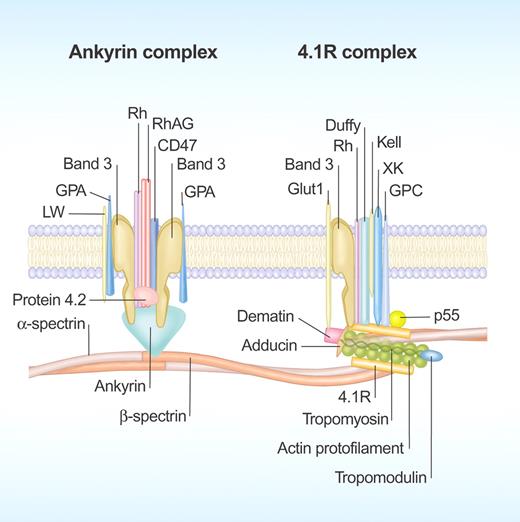Ankyrin forms bridges that connect membrane-spanning proteins to an underlying spectrin-based membrane skeleton. These bridges not only contribute critically to membrane stability, but also ensure the proper lateral distribution of membrane-spanning proteins, the assembly of signaling and structural components at the inner membrane surface, the guided trafficking of endosomes and organelles in nucleated cells, and the regulation of membrane functions by mechanical stresses.1
In erythrocytes, the spectrin-based skeleton is composed of 100-nm-long α, β-spectrin heterodimers that associate head-to-head into tetramers, which, in turn, assemble into a hexagonal lattice on the cytoplasmic surface of the membrane. This spectrin skeleton is attached to the membrane both at a junctional complex, where it associates with actin and other proteins, and near the center of each spectrin tetramer, where ankyrin forms a bridge to the anion exchanger, band 3. Although noncanonical domains exist within each spectrin tetramer, most of the tetramer is composed of 74 triple helical repeats of 106 amino acids each of which are connected to one another by an ordered continuous helix. Proteins such as ankyrin, the Lutheran blood group antigen, N-CAM, EAAT4, and NMDA-R2 bind to these spectrin repeats,1 but unfortunately, the conformational requirements for these interactions have not been elucidated.
In this issue of Blood, both Stabach et al2 and Ipsaro et al3 independently perform mapping of the ankyrin-spectrin interaction using largely nonoverlapping approaches. While both groups solve the crystal structure of repeats 14 and 15 of β-spectrin, Ipsaro et al attempted to identify the ankyrin binding site on β-spectrin by separately solving the crystal structure of a spectrin-binding fragment of ankyrin (residues 911-1068) and then examining the 2 crystal structures for charge and shape complementarity. While no obvious shape complementarity emerged, Ipsaro et al noted a patch of anionic amino acids within and adjacent to helix C of spectrin repeat 14 that matched up well with cationic amino acids in the crystallized fragment of ankyrin.
In contrast, Stabach et al elected to locate the ankyrin binding site on their crystal structure of the β-spectrin repeats by performing site-directed mutagenesis. Upon mutation of 42 carefully selected residues, they identified 14 amino acids whose mutagenesis either abrogated or compromised ankyrin binding. Importantly, several of the identified residues coincided with the anionic residues hypothesized by Ipsaro et al to comprise the ankyrin binding site. Other critical residues resided either in the linker connecting the spectrin repeats or within a loop spanning helices B and C of repeat 15.
It is the function of this latter loop that gives rise to an important distinction between the 2 papers. Stabach et al hypothesize that these loop-spanning residues control the tilt angle between β-spectrin repeats 14 and 15. Thus, unlike any other spectrin repeat structure published to date,4 the authors observe a 64° bend between the 2 spectrin repeats, and hypothesize that the pocket formed by this bend provides many of the high-affinity contacts involved in ankyrin binding. Ipsaro et al, in contrast, see no such bend, but they do observe crystallographic evidence for considerable flexibility within this region, suggesting that the linker could be flexible and that the spectrin conformer immobilized in their crystal structure assumes a nonbent conformation. Possible resolution of this discrepancy can be found in a recent online article by Davis et al5 that describes the crystal structure of the ankyrin binding domain (repeats 14-16) of β2-spectrin as having a bent structure. As observed by Stabach et al, Davis et al also find that differences in interrepeat contacts, involving an homologous loop in β2-spectrin, may be responsible for the unusual bend seen in the 2-repeat structure that binds ankyrin.
In summary, a possible unifying interpretation that emerges from all of the data are that acidic amino acids near the C-terminus of helix C in repeat 14, together with the linker connecting repeat 14 to repeat 15 and the loop linking helices B and C of repeat 15, all contribute to formation of a flexible pocket on spectrin that associates with ankyrin. Because defects in the spectrin-ankyrin function are associated with such human pathologies as hereditary spherocytosis, cardiac arrhythmia, premature aging, deafness, and ataxia,6 further examination of this very important membrane complex is clearly warranted.
A schematic representation of the red cell membrane. The membrane is a composite structure in which a plasma membrane envelope composed of amphiphilic lipid molecules is anchored to a 2-dimensional elastic network of skeletal proteins through tethering sites (transmembrane proteins) embedded in the lipid bilayer. Professional illustration by Paulette Dennis.
A schematic representation of the red cell membrane. The membrane is a composite structure in which a plasma membrane envelope composed of amphiphilic lipid molecules is anchored to a 2-dimensional elastic network of skeletal proteins through tethering sites (transmembrane proteins) embedded in the lipid bilayer. Professional illustration by Paulette Dennis.
Conflict-of-interest disclosure: The author declares no competing financial interests. ■


This feature is available to Subscribers Only
Sign In or Create an Account Close Modal